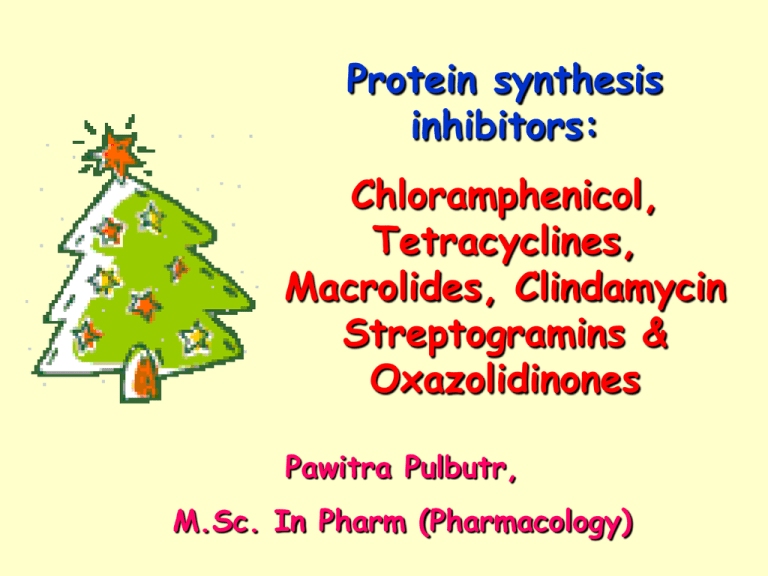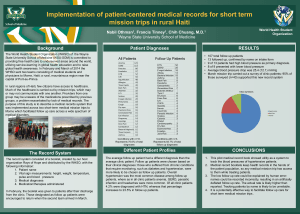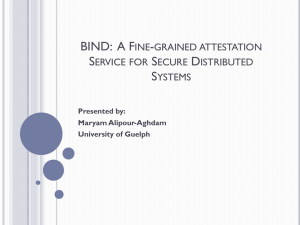Protein synthesis inhibitors: Chloramphenicol, Tetracyclines
advertisement

Protein synthesis inhibitors: Chloramphenicol, Tetracyclines, Macrolides, Clindamycin Streptogramins & Oxazolidinones Pawitra Pulbutr, M.Sc. In Pharm (Pharmacology) วัตถุประสงค์เชิงพฤติกรรม • เข้าใจและอธิบายถึงกลไกการออกฤทธิ์, กลไกการดื้อยา, เภสัช จลนศาสตร์, อาการไม่พงึ ประสงค์ท่เี กิดจากการใช้ยา, การนาไปใช้ ประโยชน์ทางคลินิก รวมทัง้ ข้อดีและข้อเสียของยาต้านแบคทีเรียในกลุม่ Protein synthesis inhibitors ได้แก่ chloramphenicol, tetracyclines, macrolides, clindamycin, streptogramins, oxazolidinones, ketolides ได้ Bacterial protein synthesis Drug acting as protein synthesis inhibitors • • • • • • • • • Chloramphenicol Tetracyclines Macrolides Clindamycin Ketolides Oxazolidinones Streptogramins Aminoglycosides Spectinomycin Chloramphenicol • First synthetic antibacterial • Mechanism of action – Bind with 50s subunit – Inhibit peptidyl transferase – Inhibit transpeptidation … connection of peptide from P-site to A-site*** – Bacteriostatic – Bactericidal to some bacteria >>>H. influenzae, N. meningitidis, bacteroides • Resistance – Decrease uptake – Chloramphenicol acetyl transferase enzyme… destroy Clinical uses o Serious rickettsial infection o Typhus … alternative to doxycycline o Bacterial meningitis (due to PRSP, meningococcus) … alternative to penicillin o Eye infection** .. Topical o Melioidosis … Burkholderia pseudomalleri (gram negative rods) ADRs • GI disturbance.. n/v, diarrhea, oral-vaginal candidiasis • Bone marrow supression*** … dose dependent…> 50 mg/kg/day for 1-2 wks • Aplastic anemia … idiosyncratic reaction… not dose dependent … 1 in 24,000-40,000 …. Fetal reaction – Unexplained infection/ Bleeding/ Fatigue • Toxicity for newborn – Immature conjugation – Gray baby syndrome … vomiting, flaccidity, hypothermia, gray color, shock, death – Not > 50 mg/kg in infants , > 25 mg in immatures Tetracyclines • • • • • • • chlortetracycline oxytetracycline tetracycline demeclocycline methacycline doxycycline minocycline Hydrochloride salt… more water soluble All chelates with divalent metal ions*** Mechanism of action • Bind with 30 s subunit • Inhibit binding of aminoacyl-tRNA to A-site • Inhibit protein synthesis • Bacteriostatic Spectrum • • • • • • Broad spectrum gram positive, negative, anaerobes rickettsiae chlamydia mycoplasma protozoa (ameba, plasmodium) Clinical uses • DOC for Mycoplasma pneumonia, Chlamydia, Rickettsia infection • Acne** • Bronchitis • Community acquired pneumonia • Lyme disease • Leptospirosis** • Vibrio infection • Atypical mycobacterial infection • H. pyroli infection … Gastric ulcer • Protozoal infection** … E. histolytica, Plasmodium (malaria) Macrolides • • • • • Macrocyclic lactone ring Erythromycin Roxithromycin Clarithromycin Azithromycin Mechanism of action • Bind 50s subunit • Inhibit aminoacyl translocation • Inhibit translocation of tRNA from A-site to P-site • Resistance • Decrease uptake or Efflux pump • Produce esterase enzyme … destroy drugs • Alteration of ribosomal binding site …. Methylase ***… MLS-B Clinical uses • DOC for … – Corynebacterium infection (diphteria*, corynebacterial sepsis, erythasma) – Respiratory, neonatal, ocular, genital Chlamydial infection* – Community acquired pneumonia • Pneumococci • Mycoplasma • Legionella Alternative to penicillin in.. • streptococci • staphylococci • pneumococci • pharyngitis • skin & soft tissue infection • pneumonia Many are resistant to macrolide too!! Endocarditis prevention in valvular heart disease pt undergoes dental surgery Ketolides • Telithromycin • Macrolide like … macrocyclic lactone ring • 3- keto group • No L-cladinose sugar • Macrolide like mechanism of action • Bind to 50s subunit • Higher affinity Spectrum • RTI caused by … beta-lactam, macrolide, tetracyclines, cotrimoxazole resistant bacteria – – – – – S. pneumoniae H. influenzae M. catarrhalis Effective to MLS-B resistance*** No MLS-B inducer Clindamycin o Cl derivative of lincomycin o Erythromycin like mechanism of action… bind at 50 s subunit o Erythromycin binding site o Spectrum o o o o o Streptococci Staphylococci Pneumococci Bacteroides & Other anaerobes*** Not effective to gram negative (poor permeability) , enterococci, Clostridium difficile Streptogramins o o o o Quinupristin-dalfopristin (Synercid®) Quinupristin = Streptogramin B 30% Dalfopristin = Streptogramin A 70% Macrolide like mechanism of action … bind at 50s subunit o Spectrum o o o o o o Gram positive bacteria** Multidrug resistant streptococci Penicillin resistant pneumococci (PRSP)** MRSA** Enterococcus faecium (not E. faecalis) Not to gram negative*** Clinical uses …. IV infusion • Vancomycin resistant E. faecium (VRE) infection • MRSA infection • Streptococci infection • Penicillin resistant/ susceptible pneumococci infection Oxazolidinones • Linezolid (Zyvox®) • Mechanism of action – – – – Bind at 23s rRNA of 50s subunit Inhibit Ribosomal assembly Unique binding site … No cross resistance Time dependent killing • Spectrum – Gram positive which resistant to other drugs – Staphylococci, Streptococci, Enterococci – Gram positive anaerobes, rods – MRSA,VRE, PRSP *** – No activity on gram negative Clinical use • VRE infection • Other multidrug resistant Tetracyclines Bind at 30s subunit Chloramphenicol bind at 50s Oxazolidinones … bind at 23s rRNA Macrolides/ Ketolides/ Clindamycin/ Streptogramins Bind at 50s subunit








